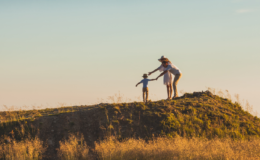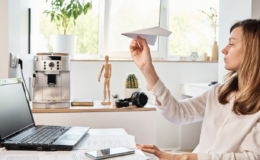We can reverse anxiety using gratitude (and a few other tools), but it’s important to know when NOT to practice as well.
While today, I’m a seasoned pro at appreciating not just the little things in my life, but also the struggles I face, gratitude was a hard concept for me during my many years of anxiety.
I knew what gratitude is.
I knew that it’s important to practice.
I knew I had things to be grateful for.
But I struggled to do it intentionally. When I did, sometimes I’d feel good in the moment, but other times I wouldn’t feel anything at all. I thought something deeper was wrong with me that I couldn’t muster up a beautiful, golden feeling of gratitude emanating from my heart.
I was told by a mentor to keep practicing gratitude anyway to help with my anxiety.
So when I felt anxious, I would list things I was grateful for (when I remembered to do it).
But I felt like I was walking in circles. It wasn’t helping. And I hear the same thing from new clients.
It wasn’t until I learned how to practice gratitude in an effective way to reverse anxiety that it all clicked for me.
I was using it at the wrong time, for the wrong reason!
Once I understood when to practice gratitude, when NOT to practice, and how to do it properly, I started breaking the cycle of anxiety.
When NOT to practice gratitude when you have anxiety
The word ‘gratitude’ often inspires happiness not just through the art of loving what you have, but also by generating a feeling of a more stable and calm life.
From the outside, it can be seen as a powerful force that can change the perspective and even heal from trauma. On the other hand, gratitude can come with a hidden danger when used at the wrong time for the wrong reason.
As an Anxiety Coach, I get a lot of clients who use gratitude journals as a tool to help with their anxiety. But they still find themselves stuck in cycles of anxiety.
Here’s why…. They are using gratitude journals as an escape strategy and avoidance technique.
- They feel anxious, stressed, overwhelmed or angry.
- They don’t want to feel that way.
- So they use gratitude journaling as a way to get away from the discomfort.
Sometimes it helps them feel better in the moment.
❌ But it doesn’t get to the root of the anxiety, nor does it help them break the cycle.
Don’t force yourself to be grateful for things you don’t want to be grateful for, when you are in a dysregulated, triggered state.
“In the midst of every crisis lies great opportunity.” While this is very much true, if you’re feeling anxious, sad, or angry, forcing yourself to focus on the positive instead of processing your uncomfortable emotion is toxic positivity.
It’s ignoring the negative by blinding ourselves with positivity.
Why practicing gratitude while anxious often doesn’t help anxiety
Of course we all need to practice gratitude!
But the INTENTION behind it MATTERS GREATLY.
If you are practicing gratitude with the intention of escaping an uncomfortable emotion, you’ll have a temporary effect at best.
What we really need in the moment of anxiety is to:
- learn how to process those uncomfortable emotions in an easeful and healthy way.
- change the internal conversation to coach ourselves through positivity instead of staying stuck in a cycle of fear and self-critical.
When to practice gratitude to reverse anxiety
We all have something to be grateful for. But sometimes it’s hard to remember all the good things in your life when you’re feeling anxious.
When we’re stressed and anxious, we are in defensive survival mode, so it’s hard to remember to practice gratitude, and we won’t be as objectively self-compassionate as we need to be to fully practice gratitude.
Gratitude journaling is most effective when the intention is purely to become more grateful.
Practice your gratitude journaling when you are already in a good emotional space (or a neutral space) in order to get the most out of it.
This way it can be used as a PROACTIVE tool to keep you in a positive headspace as opposed to a reactionary tool to escape discomfort.
How to use gratitude in an effective way to actually break the cycle of anxiety
Intention matters! Practice with the intention of becoming more grateful, not with the intention of becoming less stressed.
Less stress and anxiety are a BYPRODUCT of becoming more grateful as you are training yourself to focus on the positive and breaking the pattern of focusing on the negative.
By doing this, you are strengthening these skills:
- Thinking about things you CHOOSE to think about, as opposed to your mind automatically gravitating toward the negative
- Strengthening the neural pathways that focus on positive thoughts, weakening pathways that go to negative thoughts
- Training yourself to see opportunity where we are used to seeing limitations
How to get started practicing gratitude for anxiety
🧘♀️ First, find a quiet place where you can sit and write uninterrupted.
😮💨 Then, take a few deep breaths and focus on the present moment.
✍️ Once you’re feeling calm, start writing down everything you’re thankful for.
It can be anything from your bed, your health, or your youth to the sun shining outside.
Don’t worry if your gratitude list seems small at first.
The important thing is that you’re taking time to focus on the positive things in your life. As you practice gratitude journaling, you’ll find that it gets easier and your list will grow!
5 ways to step up your gratitude practice to reverse anxiety
Once you develop the habit of practicing gratitude intentionally, you can build on this habit and watch your positivity grow:
- Keep a gratitude journal and write down 3-5 things you’re grateful for each day.
- Share your gratitude with others by telling them what you’re thankful for.
- Practice loving-kindness meditation and focus on the present moment, including all the good things that are happening right now.
- Write a letter of gratitude to someone who has made a positive difference in your life.
- Make it a habit to notice the little things that make you happy throughout the day.
By taking the time to appreciate all the good in your life, you can help reverse anxiety and live a happier, more fulfilling life.
The bottom line
- Practice gratitude with the intention of becoming more grateful, not as a means to avoid uncomfortable emotions.
- By proactively and intentionally practicing gratitude, you’ll transform your automatic thinking to be more positive
- Focus first on creating the habit of practicing gratitude, then you can expand it and strengthen the skill
Studies show that people who wrote down things they were grateful for each week had less anxiety and depression than those who didn’t.
Comment below, what are you grateful for?
Where to go from here:
- Work with me 1:1: For leaders and parents feeling lost trying to grow and heal on their own, ready for a guide on their journey out of anxiety into the happiest, most Zen-Badass version of yourself from the boardroom to the family room.
- 21 Day Meditation-in-Action emotional transformation (now only $37). In as few as 4 minutes a day, learn how to retrain your mind for resilience, peace and focus.
- Free Training – Learn the 4 Shifts to Ease Anxiety and Find Your Inner Zen-Badass: Access the free mini-but-mighty Graceful Resilience® training to learn the skills to become calm, confident and in control over your emotions so your career and relationships thrive.






Leave a Comment